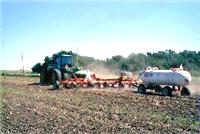
Wheat: Nutrients
Nutrients are substances
that are required by organisms for normal life and activity. These substances
are added to the soil naturally as dead plants and animals decompose.
During the breakdown of plant and animal material by decomposers, nutrients such as nitrogen and phosphorus are released to
the soil. These nutrients are then available to the living plants.
 There
are three classes of nutrients--primary nutrients, secondary
nutrients, and micronutrients. These classes are determined
by the
amounts and importance of the nutrients that are required by an organism. Primary, or
essential nutrients, are irreplaceable elements; that is to say there
is no substitute for them for the completion of a normal life cycle. The
required amount of secondary nutrients is less than that of primary
nutrients. Micronutrients are only required in extremely
small, or trace, amounts. Before planting a crop, a farmer must test the
soil in the field and determine how much of each nutrient is available
to plants. If the soil is lacking important nutrients, then they need
to be supplemented. This is similar to the human practice of taking vitamins.
Nutrients are often supplied to crops by the farmer in the form of fertilizer,
as seen in the photograph above. Photo:
Liquid fertilizer being applied to a field of wheat. Photo courtesy of
Wheat Mania.
There
are three classes of nutrients--primary nutrients, secondary
nutrients, and micronutrients. These classes are determined
by the
amounts and importance of the nutrients that are required by an organism. Primary, or
essential nutrients, are irreplaceable elements; that is to say there
is no substitute for them for the completion of a normal life cycle. The
required amount of secondary nutrients is less than that of primary
nutrients. Micronutrients are only required in extremely
small, or trace, amounts. Before planting a crop, a farmer must test the
soil in the field and determine how much of each nutrient is available
to plants. If the soil is lacking important nutrients, then they need
to be supplemented. This is similar to the human practice of taking vitamins.
Nutrients are often supplied to crops by the farmer in the form of fertilizer,
as seen in the photograph above. Photo:
Liquid fertilizer being applied to a field of wheat. Photo courtesy of
Wheat Mania.
The following are some important wheat nutrients and the conditions in which they are used:
Primary Nutrients
Nitrogen (N):
Generally, a small amount of nitrogen is applied near planting time, and
a larger amount is applied later to spur the rapid end-of-the-season growth.
When wheat is planted in a field that had yielded a legume such as soybeans
or peanuts, less nitrogen is needed because legumes are a special type
of plant that increase the amount of nitrogen available in the soil.
Phosphorus (P): Phosphorus is applied before the wheat is planted. The amount applied depends on the amount of phosphorus already in the soil.
Potassium (K): Like phosphorus, potassium is applied before the wheat is planted, and the amount applied depends on the amount of potassium already in the soil.
Secondary Nutrients
Calcium
(Ca) and magnesium (Mg):
Sufficient amounts of calcium and magnesium are usually supplied naturally
by limestone present in the soil. However, when there is not enough of
these nutrients naturally available in the soil, they may be increased
by using calcium or magnesium fertilizers.
Sulfur (S): The amount of sulfur needed by wheat depends on the amount of nitrogen available to the crop. The ratio of nitrogen to sulfur should be 15:1. When the amount of nitrogen in the plant is greater than the 15:1, sulfur-containing fertilizer is added.
Micronutrients
Copper
(Cu), zinc (Zn), and manganese (Mn):
Copper, zinc, and manganese are just three of many micronutrients that
may be added to wheat crops whenever their concentrations in the
soil become low. Some micronutrients
are sprayed directly onto the plants.
Overview
..|..
Nutrients
..|..
Temperature
..|..
Precipitation
..|..
Carbon
Dioxide
Glossary ..|..
Related
Links ..|..
References
|..
PBL
Model
Home ..|.. Teacher Pages ..|.. Modules & Activities
HTML code by Chris
Kreger
Maintained by ETE
Team
Last updated November 10, 2004
Some images © 2004 www.clipart.com
Privacy Statement and Copyright © 1997-2004 by Wheeling Jesuit University/NASA-supported Classroom of the Future. All rights reserved.
Center for Educational Technologies, Circuit Board/Apple graphic logo, and COTF Classroom of the Future logo are registered trademarks of Wheeling Jesuit University.
